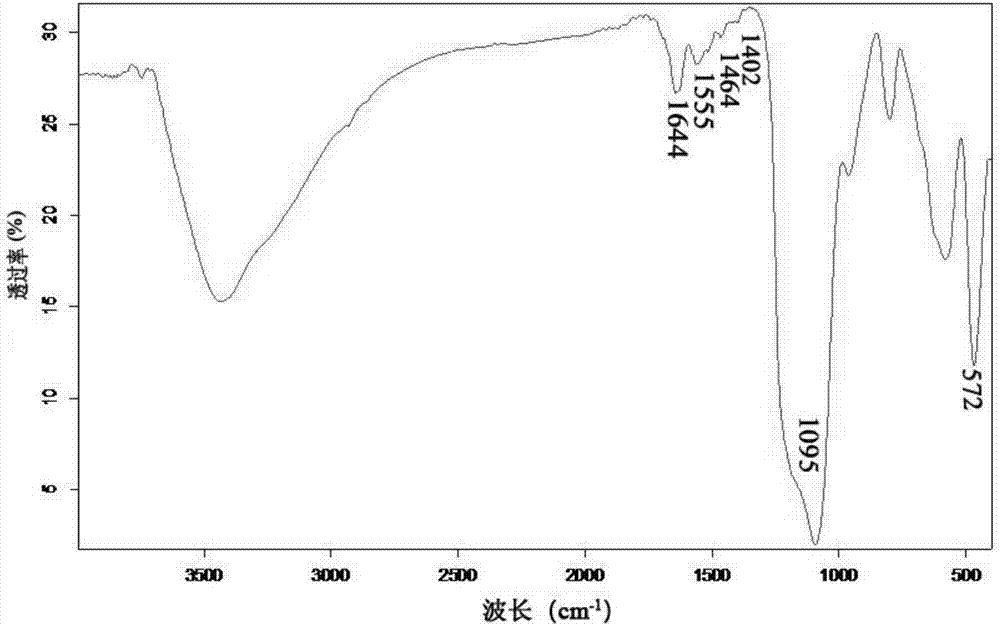Preparation method and application of functional magnetic graphene ionic liquid adsorbent
A functional bromide ion technology, applied in the field of chemical analysis and detection, can solve the problems of simultaneous qualitative and quantitative analysis of preservatives, excessive use of organic solvents, complex matrix, etc., and achieve shortened detection time, short extraction time, and organic solvents. The effect of using less
- Summary
- Abstract
- Description
- Claims
- Application Information
AI Technical Summary
Problems solved by technology
Method used
Image
Examples
preparation example Construction
[0058] The preparation method of the functional IL provided by the embodiment of the present invention comprises the following steps:
[0059] (1) 1.0g 2-sodium naphthalenesulfonate and 1.0g 1-vinyl-3 octyl-imidazole bromide (VOIm + Br - ) were dissolved in 200 mL of water respectively, and then the two solutions were mixed and mechanically stirred overnight.
[0060] (2) 250mL of chloroform was added to the separatory funnel equipped with the mixed solution to extract IL (1-vinyl-3 octyl-imidazole-2-naphthalenesulfonate), repeat the operation once, and combine the lower layer extraction twice solution.
[0061] (3) Add 300 mL of double distilled water to the separatory funnel containing the extraction solution to wash the extraction solution several times to remove bromide ions until no bromide ions are detected in the aqueous phase.
[0062] (4) The chloroform was removed from the IL extraction solution by a rotary evaporator to obtain the functional IL, which was dried u...
Embodiment 1
[0094] (1) Preparation of magnetic Fe 3 o 4 Nanoparticles:
[0095] Accurately weigh 3.40g of ammonium ferrous sulfate hexahydrate and 8.35g of ferric sulfate dodecahydrate into 400mL of water at 50°C, then add 20mL of ammonia water dropwise to precipitate iron oxide, and sonicate for 10min to adjust the pH to 11. The mixed solution was stirred for 2 h to obtain a precipitate. The precipitate was washed with first-grade water to pH 7, the obtained precipitate was dispersed in water, 1.7 mL of polyvinylpyrrolidone (PVP) was added to the mixture, and stirred at room temperature for 1 day to obtain Fe 3 o 4 nanospheres.
[0096] (2) Preparation of Fe 3 o 4 @SiO 2 :
[0097] 1.4g Fe 3 o 4 Pour the microspheres into a mixed solution containing 280mL ethanol and 70mL water, and add 5mL ammonia water. After stirring for 15 min, 4 mL of tetraethylorthosilicate (TEOS) was added dropwise. Stirring at room temperature for 8 h, the product was separated by an external magnetic...
Embodiment 2
[0109] Each process is all carried out according to embodiment 1, only the consumption of IL in the step (7) is changed into 0.2g.
PUM
 Login to View More
Login to View More Abstract
Description
Claims
Application Information
 Login to View More
Login to View More - R&D
- Intellectual Property
- Life Sciences
- Materials
- Tech Scout
- Unparalleled Data Quality
- Higher Quality Content
- 60% Fewer Hallucinations
Browse by: Latest US Patents, China's latest patents, Technical Efficacy Thesaurus, Application Domain, Technology Topic, Popular Technical Reports.
© 2025 PatSnap. All rights reserved.Legal|Privacy policy|Modern Slavery Act Transparency Statement|Sitemap|About US| Contact US: help@patsnap.com



